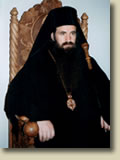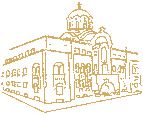| Information
Service of
the Serbian Orthodox Church
Avgust 23, 2004

BISHOP JOANIKIJE OF BUDIMLJE AND NIKSIC
ON THE
SERBIAN PEOPLE IN MONTENEGRO
 In Podgorica on August 21-22, 2004 the Serbian People’s Party
organized a scientific-expert conference entitled The Serbian
People in Montenegro: Affirmation of the national issue and defense
of human rights. Present at the gathering were Bishop Joanikije
of Budimlje and Niksic, Professor Bogoljub Sijakovic, Princess
Jelisaveta Karadjordjevic, Professor Radmilo Marojevic, Professor
Savo Lausevic, Dr. Slavenko Terzic, Dr. Momcilo Vuksanovic, Dr.
Vladimir Jovicevic, Fr. Velibor Dzomic, Budimir Aleksic, Vukic
Ilincic, Zarko Lekovic, Zelidrag Nikcevic, Milutin Micovic, Novak
Radulovic, Goran Danilovic, Predrag Vukic, Aleksandar Rakovic,
Novica Djuric and others. In Podgorica on August 21-22, 2004 the Serbian People’s Party
organized a scientific-expert conference entitled The Serbian
People in Montenegro: Affirmation of the national issue and defense
of human rights. Present at the gathering were Bishop Joanikije
of Budimlje and Niksic, Professor Bogoljub Sijakovic, Princess
Jelisaveta Karadjordjevic, Professor Radmilo Marojevic, Professor
Savo Lausevic, Dr. Slavenko Terzic, Dr. Momcilo Vuksanovic, Dr.
Vladimir Jovicevic, Fr. Velibor Dzomic, Budimir Aleksic, Vukic
Ilincic, Zarko Lekovic, Zelidrag Nikcevic, Milutin Micovic, Novak
Radulovic, Goran Danilovic, Predrag Vukic, Aleksandar Rakovic,
Novica Djuric and others.
Chief to blame for the exceptionally poor position of the Serbian
people in Montenegro, who comprise over 30 percent of the population
according to the latest census, is the regime of Milo Djukanovic.
However, a good portion of the blame also falls on the Serbs
in Montenegro themselves, who lack the courage and national strategy
to achieve what rightfully belongs to them, concluded the large
number of eminent figures taking part in the conference on the
Serbian people in Montenegro
In the opinion of His Grace Bishop Joanikije of Budimlje and
Niksic, the position of the Serbian people in Montenegro can
best be gauged according to the position of the Serbian Orthodox
Church. “The church is separated from the state; however, the
church was first the victim of aggression, and then the separation
occurred. What kind of violence do we mean? First of all, the
state simply appropriated the property of the Church. Namely,
since the forming of the Socialist Federal Republic of Yugoslavia
to present-day Montenegro, it has inherited all this Communist
capital and does not want to give it up. It is firmly holding
on to this violence and not even considering returning the Church’s
property or condemning crimes against the Church. But if the
Church says anything about the crimes perpetrated against it,
then that is the Church meddling in politics.”
According to Bishop Joanikije, the second basic right taken
from the Church is the right to religious education of children
in schools, which is guaranteed in all traditional Christian
countries. Mutual relations between the Church and state were
not legally regulated with participation of both sides; the state
simply passed a law of some sort on the position of religious
communities.
“The (Montenegrin) regime not only has no intention of organizing
and regulating these issues in a proper manner but obviously
goes even further. With the same force but with renewed will
and strength it is trying to carry out new acts of violence against
the Church,” said Bishop Joanikije. “Currently in effect is a
program endangering church jurisdiction in Montenegro, and denying
church jurisdiction represents the greatest danger for a local
Church.”

90TH ANNIVERSARY OF BATTLE OF CER CELEBRATED IN TEKERISA  Ninety years ago, from August 12-24, 1914, the Battle of Cer
took place between the Serbian and Austro-Hungarian army. With
the intent of conquering Serbia, the Austro-Hungarian command
carried out an attack from two directions, across the Drina and
Sava Rivers. After preparing a plan for the Battle of Cer the
Serbian supreme command transferred its military reinforcements
to this part of Serbia. Serbian forces numbered 180,000 soldiers
and Austro-Hungarian forces totaled 200,000. Ninety years ago, from August 12-24, 1914, the Battle of Cer
took place between the Serbian and Austro-Hungarian army. With
the intent of conquering Serbia, the Austro-Hungarian command
carried out an attack from two directions, across the Drina and
Sava Rivers. After preparing a plan for the Battle of Cer the
Serbian supreme command transferred its military reinforcements
to this part of Serbia. Serbian forces numbered 180,000 soldiers
and Austro-Hungarian forces totaled 200,000.
After a frontal attack by the Serbian army near the village
of Tekerisa, the enemy was forced to withdraw. During the last
four days, from August 16-20, battles were waged on the main
front. The Austro-Hungarian army, which had come from Bosnia,
was forced to retreat across the Drina. With the liberation of
Sabac the enemy army was pushed out of Serbia. The commander
of the Serbian army was general Stepa Stepanovic, who was promoted
to the rank of commander in chief (vojvoda) after the victory
at Cer.
On Sunday, August 22, 2004, His Holiness Patriarch Pavle together
with His Grace Bishop Lavrentije and His Grace Bishop Artemije
with the concelebration of clergy and deacons served a requiem
service for soldiers killed in the village of Tekerisa in front
of the memorial mausoleum.
Patriarch Pavle wrote the following in the visitor’s book: “On
the ninetieth anniversary of the Battle of Cer, we visited this
location of a battle for the freedom of our people with a prayer
to the Lord for the salvation of the souls of those who perished
for justice, freedom and the Honorable Cross. With blessings,
on August 22, 2004. Serbian Patriarch + Pavle.”
On behalf of the organizers of the commemoration of the anniversary
of this event, guests were welcomed and addressed by Loznica
mayor Mr. Slobodan Kaitovic. Other speakers included Serbian
vice-president Miroljub Labus and the chief of staff of the Serbia
and Montenegro Army, general-colonel Branko Krga. Official guests
included senior state officials of Serbia and Montenegro and
Republika Srpska, as well as representatives of the embassies
of France, the Russian Federation, the United States of America,
Germany, Austria and others.

FEAST OF THE HOLY TRANSFIGURATION – PATRON
SAINT’S DAY OF THE
CITY OF TREBINJE
On Thursday, August 19, 2004, on the feast of the Holy Transfiguration
of Our Lord, Metropolitan Jovan of Veles and Povardarje together
with Bishop Grigorije of Zahumlje and Herzegovina, Bishop Atanasije
of Zahumlje and Herzegovina (retired) and Bishop Jovan of Dioclea
served Hierarchal Liturgy in the Cathedral in Trebinje
The cutting of the slava cake and the blessing of the grapes
followed the end of the service. A festal religious procession
passed through the streets of Trebinje in the evening, headed
by Metropolitan Jovan together with Bishop Luka of Western Europe,
Bishop Grigorije, Bishop Atanasije, Bishop Teodosije of Lipljan,
and Bishop Maksim of Hum. High officials of Republika Srpska
were also present.
Approximately
5,000 people took part in the religious procession, which concluded
with a requiem service for all soldiers who were
killed.

[Serbian
Translation Services]

Copyright © 1999-2004 by
The Information Service of
the Serbian Orthodox Church
11000 Belgrade
Kralja Petra I no.5
+381 11 3282 596
e-mail
|

